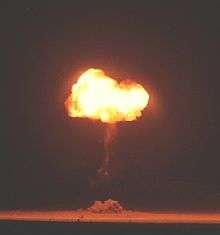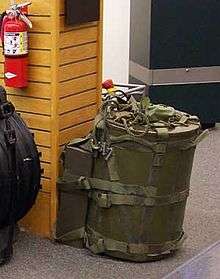W54

The W54 was one of the smallest nuclear warheads deployed by the United States. It was a very compact implosion-type nuclear weapon design, designed for tactical use and had a very low yield for a nuclear weapon.
Development

The W54 was designed by Los Alamos Scientific Laboratory and built by the United States Atomic Energy Commission. Around 400 units were manufactured from 1961 until early 1962 and were deployed until at least 1971.
Preproduction testing
The earliest identified nuclear tests of devices corresponding to the W54 characteristics were the Pascal-A and Pascal-B test detonations in 1957, in the Operation Plumbbob nuclear test series. These were both intended to have very low yield, but overshot to higher yields (tens and hundreds of tons of TNT).
These were followed by tests of the XW-51 design, which evolved into the XW-54 in the Operation Hardtack I test series in 1958 (Hardtack Quince and Hardtack Fig). These were both described as fizzles, or test failures.
A number of XW-51/XW-54 tests followed in the 1958 Operation Hardtack II test series, including Hardtack II Otero, Bernalillo, Luna, Mora, Colfax, Lea, Hamilton, Dona Ana, San Juan, Socorro, Catron, De Baca, Chavez, Humboldt, and Santa Fe. By this time, the XW-51 / XW-54 design had been test-fired more times than any preceding US nuclear weapon prior to its successful introduction in service, indicating the difficulty of successfully making this small and low-yield design work reliably and safely.
Further testing followed in the 1961 Operation Nougat test series, probably including Nougat Shrew, Boomer, Ringtail, and possibly others. By this time the W-54 design was performing consistently as expected at low yields.
Variants
There were four distinct models of the basic W54 design used, each with different yield, but the same basic design. These were:
- Mk-54 (Davy Crockett) – 10 or 20 tons yield, Davy Crockett artillery warhead
- Mk-54 (SADM) – approximate yield from 10 tons to 1 kiloton, Special Atomic Demolition Munition device
- W-54 – 250-ton yield, warhead for AIM-26 Falcon air-to-air missile
- W72 – 600-ton yield, rebuilt W-54 (Falcon warhead) for AGM-62 Walleye
Specifications
All four variants share the same basic core: a nuclear system which is 10.75 inches (273 mm) diameter, about 15.7 inches (400 mm) long, and weighs around or slightly over 50 pounds (23 kg).[1]
The W54 core, based on the available Training Manual illustrations (particularly of the Davy Crockett) was a spherical device 10.75" in diameter plus the Safe-Arm and Electronics module in the tail cone with time fuse and a Contact fuse in the nose. The best photographic interpolation match to its external dimensions is a center cylindrical section 11 inches in diameter and 5 inches long, with roughly 5.5 inch radius hemispherical nose and conic tail cone. Other pictures show a smoothly contoured 5" minor by 5.5" major axis elliptical nose with a 5" minor by 21.5" truncated elliptical tail. Four fins extend the over all length to 31", with a central hemi-spherical to cylindrical projection that serves to join the bomb to the spigot-piston that is muzzle loaded into the launcher.
Known and theoretical uses

These small-size devices were first intended for use by United States Army ground soldiers in battle and were in theory small enough to be delivered by a bazooka-style firing mechanism. Early known versions could destroy a two-block area, with an estimated yield comparable to approximately 10 tons of TNT. Larger versions were later developed with a selectable yield of between 10 and 250 tons. Though small compared to most other nuclear weapons, whose yields are usually measured in the thousands of tons of TNT (kilotons), in human terms they are still extremely large – a human might carry on his back 50 kg of chemical explosives, or 0.05 tons. By comparison, the smallest yield version of the W54 (10 tons) is two to four times as powerful as the 1995 Oklahoma City bombing, making the 250-ton version 50 to 100 times as powerful.
Several variations of the W54 are known to exist and were used in weapons projects by every branch of the U.S. armed forces except the Coast Guard.
The W54 style warhead was known to be used on the M-388 Davy Crockett, a tactical nuclear recoilless rifle projectile that was deployed by the United States during the Cold War.
The W54 is small enough to be deployed as a SADM (Special Atomic Demolition Munition), or so-called "Backpack Nuke". It was the closest thing the U.S. is known to have developed to a so-called "suitcase bomb".
The W54 was tested for use in a U.S. Navy SEAL project that was demonstrated as feasible in the mid-to-late 1960s, designed to attack a harbor or other strategic location that could be accessed from the sea. The SEAL version would be delivered into water by parachute along with a two-man team, then floated to the target, set in place and armed by hand.
The United States Air Force also developed a project using the W54, the Hughes Electronics AIM-26 Falcon. This was a larger, more powerful version of the AIM-4 Falcon air-to-air missile. It is notable for being the only known production U.S. guided air-to-air weapon with a nuclear warhead. It was intended to destroy formations of Soviet bombers at a time when guided missiles were not accurate enough to produce high-probability kills with small conventional warheads.
W72
After the AIM-26 Falcon was retired, 300 units were rebuilt into an improved configuration with a higher yield and redesignated the W72. These warheads were then used to produce a number of nuclear versions of the AGM-62 Walleye television-guided glide bomb system. The W72 variant had a yield of around 600 tons of TNT.
The 300 W72 units were produced between 1970 and 1972 and were in service until 1979.
Documented testing
Stockpiled W54 warheads were test-fired at the Nevada Test Site on July 7 and July 17, 1962. In Little Feller II (July 7), the warhead was suspended 3 feet above the ground and had a yield equivalent to 22 tons of TNT. In Little Feller I (July 17), the warhead was launched as a Davy Crockett device from a stationary 155-millimeter launcher and set to detonate between 20 and 40 feet above the ground around 1.7 miles from the launch point, with a yield of 18 tons. This test was the last atmospheric test at Nevada Test Site and was performed in conjunction with Operation Ivy Flats, a simulated military environment. It was observed by Attorney General Robert F. Kennedy and presidential adviser General Maxwell D. Taylor. Ivy Flats Film Report[2] was declassified by the United States Department of Energy on December 22, 1997. Limited operational details of early SADM projects were published prior to this declassification.
See also
References
- ↑ Data from 1st Battalion, 33rd Armor: http://www.1-33rdar.org/M388.jpg
- ↑ Declassified U.S. Nuclear Test Film #32
- List of all US Nuclear Weapons at Nuclear Weapon Archive
- W54 at GlobalSecurity.org
- The Davy Crockett at the Brookings Institution